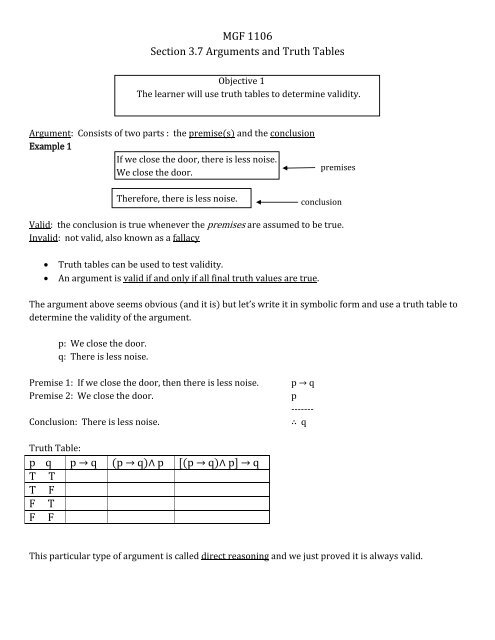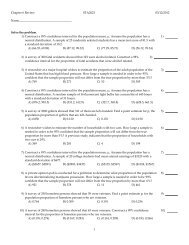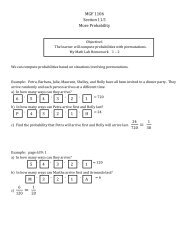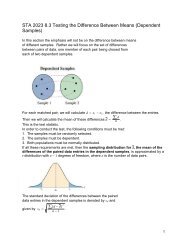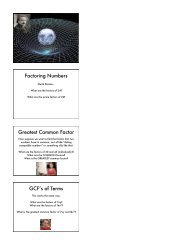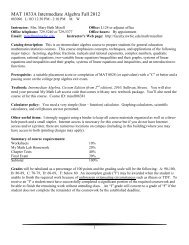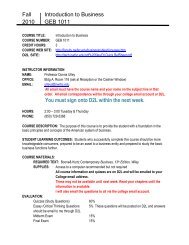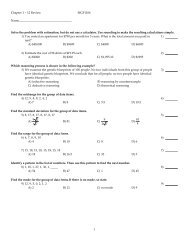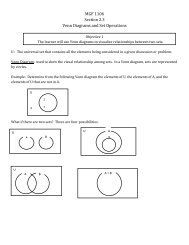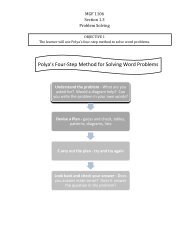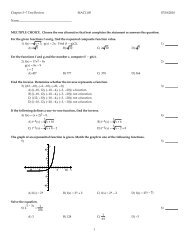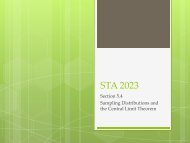MGF 1106 Section 3.7 Arguments and Truth Tables p q p → q (p ...
MGF 1106 Section 3.7 Arguments and Truth Tables p q p → q (p ...
MGF 1106 Section 3.7 Arguments and Truth Tables p q p → q (p ...
Create successful ePaper yourself
Turn your PDF publications into a flip-book with our unique Google optimized e-Paper software.
<strong>MGF</strong> <strong>1106</strong><strong>Section</strong> <strong>3.7</strong> <strong>Arguments</strong> <strong>and</strong> <strong>Truth</strong> <strong>Tables</strong>Objective 1The learner will use truth tables to determine validity.Argument: Consists of two parts : the premise(s) <strong>and</strong> the conclusionExample 1If we close the door, there is less noise.We close the door.premisesTherefore, there is less noise.conclusionValid: the conclusion is true whenever the premises are assumed to be true.Invalid: not valid, also known as a fallacy<strong>Truth</strong> tables can be used to test validity.An argument is valid if <strong>and</strong> only if all final truth values are true.The argument above seems obvious (<strong>and</strong> it is) but let’s write it in symbolic form <strong>and</strong> use a truth table todetermine the validity of the argument.p: We close the door.q: There is less noise.Premise 1: If we close the door, then there is less noise.Premise 2: We close the door.Conclusion: There is less noise.p → qp-------∴ q<strong>Truth</strong> Table:p q p → q (p → q)∧ p [(p → q)∧ p] → qT TT FF TF FThis particular type of argument is called direct reasoning <strong>and</strong> we just proved it is always valid.
Example 2: Use a truth table to determine whether the symbolic form of the argument is valid or invalid.a) p → q~p-------∴ ~qp q p → q ~p (p → q)∧ ~p ~q [(p → q)∧ ~p] → ~qT TTFFFTFb) p → qq--------∴ pp q p → q (p → q)∧ q [(p → q)∧ q] → pT TTFFFTFc) p → q~q----------∴ ~pp q p → q ~q (p → q)⋀~q ~p [(p → q)⋀~q]→~pT TTFFFTF
d) p → qq→ r-------∴ p → rp q r p → q q → r (p → q)⋀ (q → r) p → r [(p → q)⋀ (q → r)]→ (p →r)T T TTTTT FF TF FF T TF T FF F TF F FExample 3If I tell you I cheated, I’m miserable. If I don’t tell you I cheated, I’m miserable.∴ I’m miserable.p: I tell you I cheatedq: I am miserableSymbolic Form:<strong>Truth</strong> Tablep q p → q ~p ~p → q (p → q) ⋀(~p → q) [(p → q) ⋀(~p → q)]→qT TTFFFTF
Objective 2The learner will recognize <strong>and</strong> use forms of valid <strong>and</strong> invalid arguments.ValidInvalidDirectp → qp------∴ qFallacy of the Conversep → qq------∴ pContrapositivep → q~q------∴ ~pFallacy of the Inversep → q~p------∴ ~qDisjunctivep ∨ q~p-------∴ q(also valid for ~q, p)Misuse of Disjunctivep ∨ qp-------∴ ~q(also invalid for q, ~p)Transitivep → qq→ r-------∴ p → r(also valid for ~r → ~p)Misuse of Transitivep → qq→ r-------∴ r →p(also invalid for ~p → ~r)
Example 4: Determine if each argument is valid or invalidArgumentIf we’re out of gas, then the car won’t start.If the car won’t start, then we’ll miss the party.∴ If we’re out of gas, then we’ll miss the party.If we’re out of gas, then the car won’t start.If the car won’t start, then we’ll miss the party.∴ If we miss the party, then we’re out of gas.If I am happy, I paint with purple.I am not happy.∴ I did not paint with purple.If I am happy, I paint with purple.I did not paint with purple.∴ I am not happy.We study longer, or we don’t underst<strong>and</strong> the material.We do not study longer.∴ We don’t underst<strong>and</strong> the material.We study longer, or we don’t underst<strong>and</strong> the material.We study longer.∴ We underst<strong>and</strong> the material.If all people obey the law, then no jails are needed.Some jails are needed.∴ Some people do not obey the law.If all people obey the law, then no jails are needed.Some people do not obey the law.∴ Some jails are needed.SymbolicFormValidor Invalid?ReasonExample 5: Form a valid conclusion based on the given premises.a) If a painter mixes red <strong>and</strong> blue, then he’ll make purple.A painter doesn’t make purple.Therefore …b) If a person breaks the law, then the person will be arrested.If a person is arrested, then the person will go to jail.A person broke the law.Therefore …
Example 6Write each argument symbolically. Then write a valid conclusion symbolically <strong>and</strong> in words.p: He is a painter. m: He mixes yellow <strong>and</strong> blue.g: He makes green. R: He is Rembr<strong>and</strong>t.1. He is Rembr<strong>and</strong>t or he does not mix yellow <strong>and</strong> blue.He is not Rembr<strong>and</strong>t.∴2. If he makes green, then he is not Rembr<strong>and</strong>t.He is Rembr<strong>and</strong>t.∴3. If he is Rembr<strong>and</strong>t, then he does not make green.If mixes yellow <strong>and</strong> blue, then he does make green.∴4. If a painter mixes yellow <strong>and</strong> blue, then he’ll make green.If he doesn’t make green, then he is not a painter.If he is Rembr<strong>and</strong>t, then he is a painter.∴


